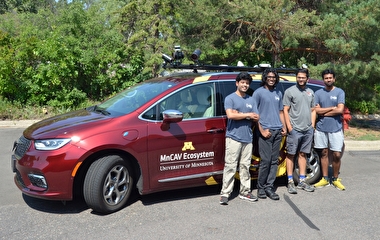
Automated vehicle (AV) technology is developing rapidly—meaning the profound impacts AVs will have on our society’s equity, economy, and environment are quickly approaching. This moment on the cusp of major changes leaves transportation policymakers at a critical crossroads.
“AVs have the potential to either foster a more equitable future or exacerbate existing accessibility gaps,” says Frank Douma, a researcher at the U of M’s Humphrey School of Public Affairs. “While some say we are on the road to ‘AV hell,’ there is still time to change course towards an ‘AV heaven’ in which AV policies improve transportation equity.”
Two new studies conducted through a National Science Foundation grant reveal how AVs may affect people who face transportation disadvantages. The studies also identify policies needed to bolster the positive impacts of AVs while buffering or eliminating the negative impacts for these groups. The studies were led by Douma and Professor Jason Cao of the Humphrey School.
The first study examined the impacts of vehicle automation on different groups of transport-disadvantaged people. Researchers found that some groups will experience mixed impacts: People with low incomes, racial minorities, immigrants, and women will encounter a relatively even mix of challenges and benefits.
For example, individual ownership would make AVs even less affordable than conventional vehicles for people with low incomes, but “fractional” car ownership would allow several households to purchase or lease a vehicle and share insurance, gas, and maintenance costs, Cao says.
For other groups, benefits will likely outweigh challenges. People with disabilities, seniors, and teenagers would gain greater mobility and independence, and rural residents would also benefit from less geographic isolation.
Overall, the impacts of AVs—particularly for transportation disadvantaged groups—will depend on the design of policies. “We believe policies and regulations will be necessary to achieve positive influences and mitigate negative effects of AVs,” says Xinyi Wu, a graduate student on the research team (now a postdoctoral researcher at Argonne National Laboratory). The team recommends policies in four areas:
- Transit: Ensure adequate services for the transit-dependent population; provide innovative services such as automated feeder buses; develop new job opportunities for displaced transit operators.
- Nonmotorized infrastructure: Reinforce the role of nonmotorized travel in the transportation system through comprehensive plans and zoning regulations.
- Shared mobility: Promote shared AV ownership through policies such as regulations for fractional car insurance.
- Inclusion: Include major population groups in policymaking processes; ensure that AVs recognize people of varying physical characteristics; run pilot programs to build trust in AVs, especially among women and seniors, who tend to consider AVs unsafe.
A second project studied the current landscape of AV policies that have equity implications. Researchers combed through academic and other literature such as policies, reports, guidelines, playbooks, white papers, and articles and grouped the policies into three categories: access and inclusion, multimodal transportation, and community well-being. Their analysis of these policies sought to uncover patterns, frequencies, and gaps.

“We found that considerations for a shared-use AV model and impacts to the economy dominate the policy landscape,” says Katie Emory, a graduate student on the research team (now a planner at HNTB). “Considerations for people with low incomes and people of color are not well represented.”
Other prevalent issues were urban parking, automating transit, and helping marginalized communities. In contrast, little work has been done to address personal security issues within shared vehicles or models for deploying AVs in rural communities, Emory says.
This research team found that overall, while some organizations have begun to create AV policy, many others have not. The researchers say now is the time for policymakers to shape an AV policy framework to ensure the most equitable outcomes.
“Transportation planners, policymakers, and government officials have the power to shape the first transportation revolution of this millennium,” Douma says. “Their actions now may guide outcomes for years to come.”
The team recommends that planners and policymakers look to thought leaders, planners, and businesses to “dream big”—and to other governments to see what policy has actually been enacted. Officials also should adapt policy to the unique needs of their local jurisdictions and remain aware that policies cannot be created in a vacuum. “An overarching policy framework is the best way to ensure policies support and enhance one another,” Douma says.
The studies were part of the “Connecting the Smart-City Paradigm with a Sustainable Urban Infrastructure Systems Framework to Advance Equity in Communities” NSF grant (1737633) led by Shashi Shekhar, McKnight Distinguished Professor in the Department of Computer Science and Engineering.
Writer: Megan Tsai


